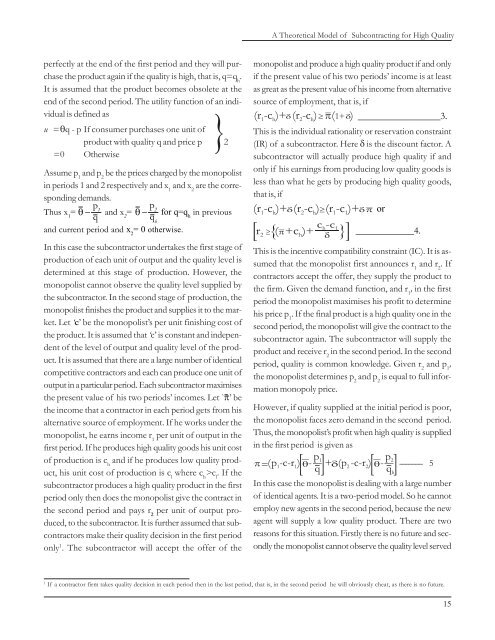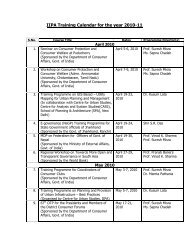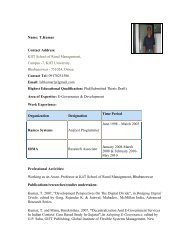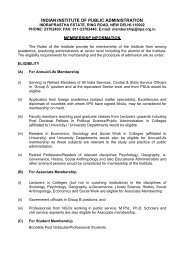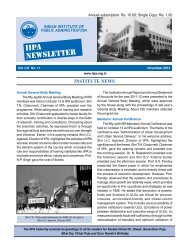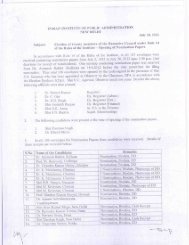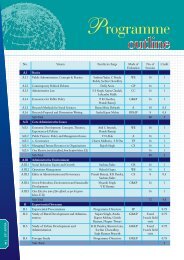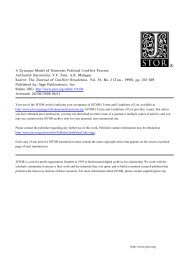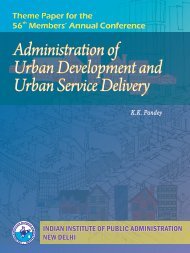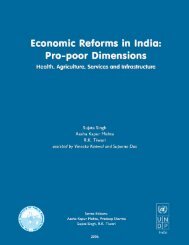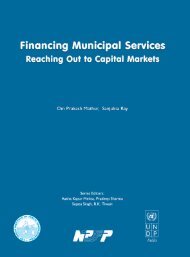Subcontracting and Economic - Indian Institute of Public Administration
Subcontracting and Economic - Indian Institute of Public Administration
Subcontracting and Economic - Indian Institute of Public Administration
Create successful ePaper yourself
Turn your PDF publications into a flip-book with our unique Google optimized e-Paper software.
A Theoretical Model <strong>of</strong> <strong>Subcontracting</strong> for High Quality<br />
perfectly at the end <strong>of</strong> the first period <strong>and</strong> they will purchase<br />
the product again if the quality is high, that is, q=q h<br />
.<br />
It is assumed that the product becomes obsolete at the<br />
end <strong>of</strong> the second period. The utility function <strong>of</strong> an individual<br />
is defined as<br />
}<br />
u =θq - p If consumer purchases one unit <strong>of</strong><br />
product with quality q <strong>and</strong> price p 2<br />
=0 Otherwise<br />
Assume p 1<br />
<strong>and</strong> p 2<br />
be the prices charged by the monopolist<br />
in periods 1 <strong>and</strong> 2 respectively <strong>and</strong> x 1<br />
<strong>and</strong> x 2<br />
are the corresponding<br />
dem<strong>and</strong>s.<br />
p<br />
Thus x 1<br />
= 1<br />
p θ − <strong>and</strong> x 2<br />
= θ − 2<br />
for q=q h<br />
in previous<br />
q qh<br />
<strong>and</strong> current period <strong>and</strong> x 2<br />
= 0 otherwise.<br />
In this case the subcontractor undertakes the first stage <strong>of</strong><br />
production <strong>of</strong> each unit <strong>of</strong> output <strong>and</strong> the quality level is<br />
determined at this stage <strong>of</strong> production. However, the<br />
monopolist cannot observe the quality level supplied by<br />
the subcontractor. In the second stage <strong>of</strong> production, the<br />
monopolist finishes the product <strong>and</strong> supplies it to the market.<br />
Let ‘c’ be the monopolist’s per unit finishing cost <strong>of</strong><br />
the product. It is assumed that ‘c’ is constant <strong>and</strong> independent<br />
<strong>of</strong> the level <strong>of</strong> output <strong>and</strong> quality level <strong>of</strong> the product.<br />
It is assumed that there are a large number <strong>of</strong> identical<br />
competitive contractors <strong>and</strong> each can produce one unit <strong>of</strong><br />
output in a particular period. Each subcontractor maximises<br />
the present value <strong>of</strong> his two periods’ incomes. Let `π’ be<br />
the income that a contractor in each period gets from his<br />
alternative source <strong>of</strong> employment. If he works under the<br />
monopolist, he earns income r 1<br />
per unit <strong>of</strong> output in the<br />
first period. If he produces high quality goods his unit cost<br />
<strong>of</strong> production is c h<br />
<strong>and</strong> if he produces low quality product,<br />
his unit cost <strong>of</strong> production is c l<br />
where c h<br />
>c l<br />
. If the<br />
subcontractor produces a high quality product in the first<br />
period only then does the monopolist give the contract in<br />
the second period <strong>and</strong> pays r 2<br />
per unit <strong>of</strong> output produced,<br />
to the subcontractor. It is further assumed that subcontractors<br />
make their quality decision in the first period<br />
only 1 . The subcontractor will accept the <strong>of</strong>fer <strong>of</strong> the<br />
monopolist <strong>and</strong> produce a high quality product if <strong>and</strong> only<br />
if the present value <strong>of</strong> his two periods’ income is at least<br />
as great as the present value <strong>of</strong> his income from alternative<br />
source <strong>of</strong> employment, that is, if<br />
_________________3.<br />
This is the individual rationality or reservation constraint<br />
(IR) <strong>of</strong> a subcontractor. Here δ is the discount factor. A<br />
subcontractor will actually produce high quality if <strong>and</strong><br />
only if his earnings from producing low quality goods is<br />
less than what he gets by producing high quality goods,<br />
that is, if<br />
or<br />
____________4.<br />
This is the incentive compatibility constraint (IC). It is assumed<br />
that the monopolist first announces r 1<br />
<strong>and</strong> r 2<br />
. If<br />
contractors accept the <strong>of</strong>fer, they supply the product to<br />
the firm. Given the dem<strong>and</strong> function, <strong>and</strong> r 1<br />
, in the first<br />
period the monopolist maximises his pr<strong>of</strong>it to determine<br />
his price p 1<br />
. If the final product is a high quality one in the<br />
second period, the monopolist will give the contract to the<br />
subcontractor again. The subcontractor will supply the<br />
product <strong>and</strong> receive r 2<br />
in the second period. In the second<br />
period, quality is common knowledge. Given r 2<br />
<strong>and</strong> p 1<br />
,<br />
the monopolist determines p 2<br />
<strong>and</strong> p 2<br />
is equal to full information<br />
monopoly price.<br />
However, if quality supplied at the initial period is poor,<br />
the monopolist faces zero dem<strong>and</strong> in the second period.<br />
Thus, the monopolist’s pr<strong>of</strong>it when high quality is supplied<br />
in the first period is given as<br />
---------------- 5<br />
In this case the monopolist is dealing with a large number<br />
<strong>of</strong> identical agents. It is a two-period model. So he cannot<br />
employ new agents in the second period, because the new<br />
agent will supply a low quality product. There are two<br />
reasons for this situation. Firstly there is no future <strong>and</strong> secondly<br />
the monopolist cannot observe the quality level served<br />
1<br />
If a contractor firm takes quality decision in each period then in the last period, that is, in the second period he will obviously cheat, as there is no future.<br />
15


